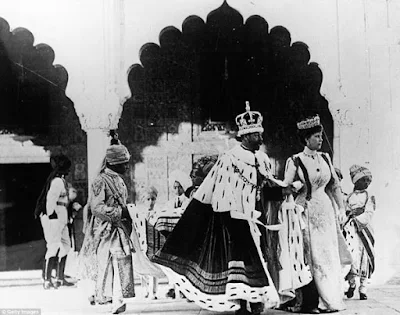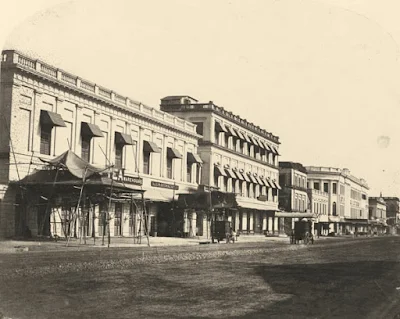Monday, December 30, 2019
How Imran Khan and Maulana Fazal ur Rahman join Hands
Imran Khan's choice of candidate for prime minister has left many of his ardent fans, especially women, dumbfounded. The cricketer-turned-politician voted for Maulana Fazlur Rehman, the Muttahida Majlis-e-Amal's nominee for premier, against the advise of many liberal and progressive members within his Tehrik-e-Insaaf (TI). Imran used his solitary vote in parliament in Rehman's favour, forwarding the argument that the MMA is the only political force that is independent and does not take dictation from abroad. He maintained that he found himself ideologically and politically close to the MMA, which denounces President Pervez Musharraf's support to the international coalition in the war against terrorism, especially in neighbouring Afghanistan. "Khan has more than a soft corner for the ousted Afghan Taliban," a senior leader of his party said on the condition of anonymity. "He thinks that the orthodox religious militia did a great service to Afghanistan and Islam before they became a target of the Americans." Also, the MMA's firm stand against Musharraf, especially his series of controversial constitutional amendments, won the heart of Pakistan's former speedster, he added. Imran's protracted bitterness towards the Pakistan Peoples' Party and anger against the Pakistan Muslim League left him with no alternative other than the MMA, which secured 86 votes, including those of the Pakistan Muslim League (N). Khan's vote for the pro-Taliban cleric has added to the political confusion within his party, which performed poorly in the October 10 elections. "It would have been understandable, had Imran voted for a candidate that was nominated jointly by the opposition," said a senior Tehrik-e-Insaaf leader. "But by voting for the MMA, he most certainly has lost his standing among the liberal, democratic and progressive elements in society." Human rights groups and the majority of the moderate and liberal Muslims have been extremely critical of the MMA's narrow interpretation of Islam and the conservative views of its leaders on women, education, fine arts, television and sports. By voting for the MMA, the Tehrik-e-Insaaf chief has, in effect, endorsed the religious alliance's stand on these issues as well. Will the women's wing of the Tehrik-e-Insaaf, led by Jemima, Khan's British-born wife, endorse the Taliban-like interpretation of Islam? That remains a moot point. Mairaj Mohammed Khan, the Tehrik-e-Insaaf's secretary general who has spent a lifetime advocating socialism and secular politics, finds it hard to defend the somersaults of the party leader, who has drifted from one extreme (of being pro-Musharraf) to the other extreme (of being anti-Musharraf) within a short span of time. REFERENCE: Will the Real Imran Please Stand Up? By Amir Zia 9 DECEMBER 2002
Friday, December 27, 2019
Sunday, December 22, 2019
A Look Into India After 1857 War
This is a Short Pictorial depicting Life after 1857.
Five months after being coroneted alongside Queen Mary at Westminster Abbey on June 22, 1911, the royal couple travelled to India
King George V of Great Britain is pictured hunting a tiger during the 10-day expedition in Nepal in 1911 - following the Delhi Durbar in India
Former Gaekwar of Baroda, Maharajah Sayyaji Rao III, caused uproar at the ceremony when he gave one quick bow to the couple before turning and walking away laughing
This picture by an unknown Delhi artist might be seen as 'propaganda to gloss over past tensions between the Scindia dynasty and the British East India Company'. The Scindia (or Sindhia) dynasty, based from the late eighteenth century in Gwalior, ruled part of the larger Maratha confederation, Tate Britain said, pointing out that in 1818 the Scindias became clients of the British. The picture shows a British military officer - probably a light cavalryman - and naval colleague being entertained by a dance
Jai Singh Prabhakar, who was the Rahib Sahib of Ullwar (Alwar) from 1892 to 1937, was the only son of the region's previous ruler, Sir Mangal Singh Prabhakar Bahadur, and is shown here circa 1887 before he was crowned aged just 10
Begum Zenat Mahat, who was wife to the Bahadar Shah Zafar, was exiled to Rangoon after the Indian Rebellion of 1857
Colonel Brayzier, an Indian soldier shown here sitting sword-ready at the time of the 1857 Indian Rebellion, just before the British Raj, which ran from 1858 to 1947
This 1859 picture of the Taj Mahal in Agra as seen from the Jumna tributary of the Ganges
This is the devastation that was wrought by a mine, which exploded in the Chutter Munzil during the siege of Lucknow
The Khynabee Gate mosque in Delhi, photographed at the time of the Indian uprising against British colonial rule
These Sikh officers were part of the Hodson's Horse, a cavalry regiment of the Indian Army. This photo, shot before the British Raj in 1857, is also included in the display of pictures given to Queen Victoria.
These Sikh officers of Afghanistan served in the Hodson's Horse regiment of the British Army and are shown here during the Indian Rebellion of 1858
At odds: In contrast to his close relationship with George V, Nicholas II found Kaiser Wilhelm difficult
Five months after being coroneted alongside Queen Mary at Westminster Abbey on June 22, 1911, the royal couple travelled to India
King George V of Great Britain is pictured hunting a tiger during the 10-day expedition in Nepal in 1911 - following the Delhi Durbar in India
Former Gaekwar of Baroda, Maharajah Sayyaji Rao III, caused uproar at the ceremony when he gave one quick bow to the couple before turning and walking away laughing
This picture by an unknown Delhi artist might be seen as 'propaganda to gloss over past tensions between the Scindia dynasty and the British East India Company'. The Scindia (or Sindhia) dynasty, based from the late eighteenth century in Gwalior, ruled part of the larger Maratha confederation, Tate Britain said, pointing out that in 1818 the Scindias became clients of the British. The picture shows a British military officer - probably a light cavalryman - and naval colleague being entertained by a dance
Begum Zenat Mahat, who was wife to the Bahadar Shah Zafar, was exiled to Rangoon after the Indian Rebellion of 1857
Colonel Brayzier, an Indian soldier shown here sitting sword-ready at the time of the 1857 Indian Rebellion, just before the British Raj, which ran from 1858 to 1947
This 1859 picture of the Taj Mahal in Agra as seen from the Jumna tributary of the Ganges
This is the devastation that was wrought by a mine, which exploded in the Chutter Munzil during the siege of Lucknow
This 1858 shot shows the entrance to a temple in Dehli and is just one of the photos given to Queen Victoria in the hope of instilling insight into the daily lives of ordinary Indians
The Khynabee Gate mosque in Delhi, photographed at the time of the Indian uprising against British colonial rule
These Sikh officers were part of the Hodson's Horse, a cavalry regiment of the Indian Army. This photo, shot before the British Raj in 1857, is also included in the display of pictures given to Queen Victoria.
These Sikh officers of Afghanistan served in the Hodson's Horse regiment of the British Army and are shown here during the Indian Rebellion of 1858
Saturday, December 14, 2019
Thursday, December 5, 2019
Benazir Bhutto Connection with India
Slain former Pakistan premier Benazir Bhutto had a thick Gujarat connection.
Around the time of Indian independence, the princely State of Junagadh was ruled by Nawab Mohabbat Ali Khan. Benazir's grand father Shah Nawaz Bhutto, son of a rich landlord family of Sindh, (then in India) studied in Panchgini. Pakistan's founder Mohammad Ali Jinnah sent him to Junagadh to assist Diwan (prime minister) Kader Mehmood Hussein
About four months before the independence, Kader Mehmood fell ill and left for London for treatment. Shah Nawaz became the Diwan of the culturally-rich State of Junagadh by accident for a short but volatile period. His 20-month stay in Junagadh left a deep imprint in the minds of people.
Shah Nawaz's prime minister-ship lasted five months and 11 days. His diplomacy failed to grab Junagadh from India. Junagadh could have become another 'Kashmir' had people not resisted Nawab-Bhuttos strategy. Bhutto advised and helped the Nawab to pass the resolution to merge Junagadh into newly-born Pakistan. The local people reacted angrily against the move.
The nationalists for the Arzee Haqumat (incidently, Dhirubhai Ambani was also a foot soldier of the movement in Junagadh) to fight back the Nawab-Bhutto gameplan. The people revolted so immensely that the Nawab and Bhutto escaped to Pakistan, leaving behind their properties.
Even this picture was thrown away from Darbargadh, palace of Nawab by the angry crowd. Now, its preserved by historian Parimal Rupani.
Historical Resources to study Bahrain with Qatar Digital Library
The Qatar Digitial Library (QDL), launched by the British Library-Qatar Foundation Partnership in October 2014, contains a huge – and growing – number of British colonial documents related to the history of the Persian Gulf and broader Middle East from the 18th to 20th Century, all of which are now freely available to search and download. This post will introduce two series of documents on the QDL that are useful for those interested in the history of Bahrain and the surrounding region in the first half of the twentieth century; namely the Intelligence Summaries of the British Political Agency in Bahrain and the Government of Bahrain’s Annual Administrative Reports
H, Highness Sheikh Sir salam
Law Courts North Aspect
The Government Hospital
A Small Pealing Dhow
Technical School
A Photographic Tour of Iraq in 1906 By a Britisher
 |
| ‘Mosque and minaret of colored tiles at Basra’. |
In November 1906, Willfred Malleson a British military intelligence officer, departed from Simla in British India on an intelligence-gathering tour of the Persian Gulf and what British officials then termed ‘Turkish Arabia’ (the south of modern Iraq, then part of the Ottoman Empire). Britain was already the dominant imperial power in the Gulf and was keen to ascertain the situation in those territories to its north that remained under the sway of the Ottomans. Malleson’s report of the Journey – that included stops in Muscat, Kuwait, Basra, Baghdad and Mohammerah – provides a fascinating snapshot of the region at this time.
 |
| A Street in Bagdad’ |
 |
| Cafe and mosque near the North Gate, Bagdad’. |
 |
| House of the dragoman [translator] of British Consulate Basra’, 1906 |
 |
| Our conveyance across the desert to Babylon |
 |
| The arch of Ctesiphon’. |
 |
| The only arch so far discovered in Babylon’ |
 |
| View in Baghdad |
 |
| ‘Bahreini pilgrims on board the Khalifa’. |
 |
| ‘Near the big mosque, Bagdad’ Medieval Baghdad, |
 |
| ‘The British Consulate and Messrs Lynch’s offices Basra; Showing 4,000 tons of merchandise awaiting shipment to Bagdad’ |
Subscribe to:
Comments (Atom)

















































